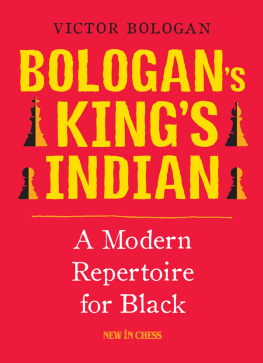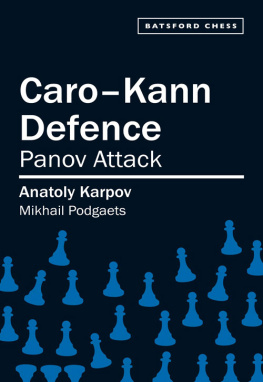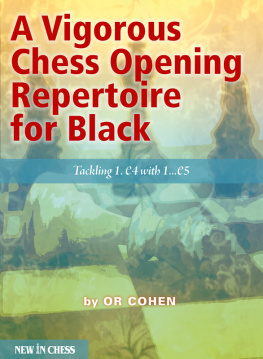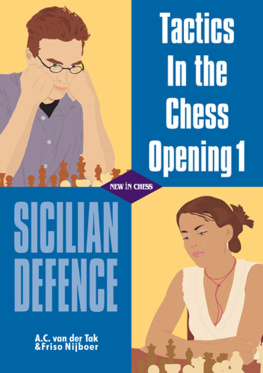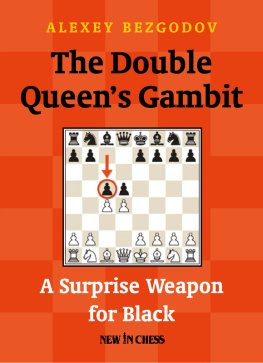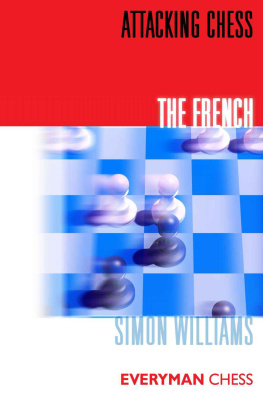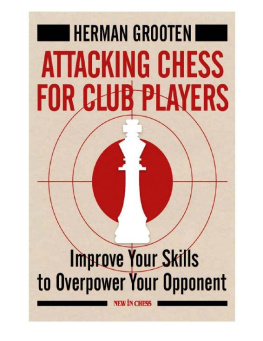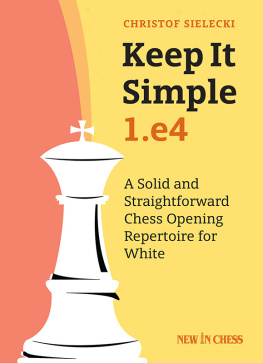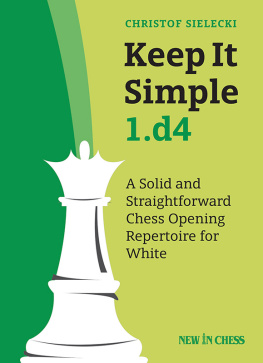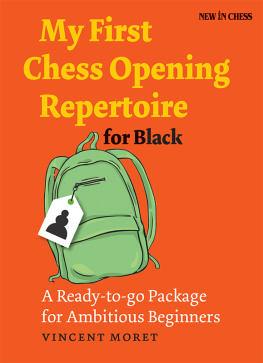Bologans Kings Indian
Victor Bologan
Bologans Kings Indian
A Modern Repertoire for Black
New In Chess 2017
2017 New In Chess
Published by New In Chess, Alkmaar, The Netherlands www.newinchess.com
Improved, updated & expanded from the original book The Kings Indian by Victor Bologan (Chess Stars 2009)
All rights reserved. No part of this book may be reproduced, stored in a retrieval system or transmitted in any form or by any means, electronic, mechanical, photocopying, recording or otherwise, without the prior written permission from the publisher.
Cover design: Volken Beck
Supervision: Peter Boel
Translation: Steve Giddins
Proofreading: Maaike Keetman
Production: Anton Schermer
Have you found any errors in this book?
Please send your remarks to and implement them in a possible next edition.
ISBN: 978-90-5691-720-3
FOREWORD
The Kings Indian cottage
The Kings Indian is probably the most romantic response against 1.d4, one which has stood the test of time and continues to this day to be used at the very highest levels of the game. For the time being, Black leaves his opponent a virtually free hand in the centre and instead hides within his KID cottage, relying on the strength of his powerful fianchettoed bishop.
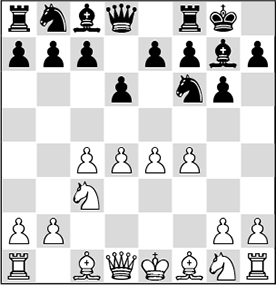
This position arose in the very first Kings Indian game which has come down to us today (i.e. has entered into the computer databases). This was played at Leipzig in 1879, with the black pieces being played by the great German theoretician Louis Paulsen. The Hungarian playing White, Adolf Schwarz, was probably bewildered as to why his opponent, breaking all the accepted canons of play of the day, had granted him a free hand in the centre, and Schwarz happily advanced all four pawns to the fourth rank. However, Whites beautiful-looking phalanx soon started crumbling from both sides and ironically, the game was decided by a black passed pawn on the d-file.
However, this was just one isolated episode; neither Paulsen nor Schwarz realised that the Four Pawns Attack, which they had played, would retain its topicality right down to the present time. Indeed, even the name of the opening was not bestowed until some 40 years later, by the light hand of Savielly Tartakower (who else?). By then, the 1920s, the Kings Indian was being used regularly by future World Champion Max Euwe and it was also seen quite often in the game of World Championship candidate Efim Bogoljubow. Later, the ranks of Kings Indian players were to include Miguel Najdorf, Andre Lilienthal and also another future World Champion, Vasily Smyslov.
Even so, the real flowering of the Kings Indian occurred during the 1940s-1950s, when it was subjected to real deep study by such capital theoreticians and strong practical players as Isaac Boleslavsky, David Bronstein and Efim Geller. Their opponents were no slouches either, as one can see by recalling just two names, both World Champions Mikhail Botvinnik and Tigran Petrosian (ironically, Tigran Vartanovich was famously to say later that he had fed his family for years on the proceeds of the Kings Indian from the white side!).
The theory of this popular opening began to develop extremely rapidly. From time to time, it was be announced that the KID had been refuted or was incorrect and should be consigned to the archives, but like a phoenix, it would always rise from the ashes.
Yes, in order to play the KID one needs to be something of a romantic and a poet: to believe in the irresistible strength of the bishop on g7, the power of ones kingside attack, the triumph of spirit over material. Another thing which characterises the KID is the continuity of generations. It is not just trainers who pass on the love and knowledge of the KID to their pupils. Among the current generation, the opening is used successfully by Teimour Radjabov, Hikaru Nakamura and Alexander Grischuk; and a high level of mastery of the opening is also shown by the Chinese star Ding Liren. The Israeli GM Ilya Smirin continues to delight fans with his sparkling and energetic interpretation of the opening, and he has also written an excellent book on it called Kings Indian Warfare!. And although his handling of the classical variation differs from mine in this book, I nonetheless recommend his games for all-round study. I myself play more and more rarely in serious tournaments these days, but whenever I need to win to order as Black, I choose the KID and I try to pass onto my pupils my love for this complicated, sharp, risky, but also remarkable opening!
But we should end our short historical and lyrical excursion, else we may get carried away and never get to the nub of the matter. The book which you are holding in your hands is quite personal: it is not a textbook on a popular variation, but a KID, Bologan-style, in which I write about how I understand and play this opening.
My romance with the KID started in my childhood in the 1970s. My first trainer Ivan Yakovlevich Solonar decided, very sensibly, that he would equip his group with Fischers opening repertoire! And the 11th World Champions repertoire included the KID, with over a tenth of his games involving that opening. Typically, Fischers statistics were deadly: 66-40 in his favour. Incidentally, another World Champion and KID specialist, Garry Kasparov, had an even more crushing record: 91-53, including a few rapid games.
Frankly speaking, I can recall little about these early lessons, since in those days, the openings were only a small part of our study and it was more important simply to learn to play chess. Even so, the foundations were laid and then the process went on. The KID was very popular in Moldavia. I studied for just one month with master Nikolai Popov, (now a well-known sports commentator), but his explanations about how to play against the fianchetto variation I remember to this day.
A special place in my understanding of the KID is occupied by the ideas of the great Moldavian trainer Vyacheslav Andreevich Chebanenko. He was fundamentally different from todays modern KID players, even one may say retro, in his belief that the black queens knight should be placed on d7. Despite their apparent passivity, his schemes brought us excellent results, and some of them, for example 7bd7 against the Gligoric System, have retained their topicality to this day.
Even so, nowadays I play the KID along the lines of the Latvian theoretician Zigurds Lanka. Recalling the lines he showed me in the early 1990s, I browsed through my old notebooks from the period and compared his variations with those I play now and could not find a single difference. All the main lines were one and the same. In recent times, an important element of opening preparation has been the study of correspondence games and also games between computers. To my great pleasure, I have found that the majority of my lines have stood the test of time and computer. A remarkable success and longevity for Lankas dogmas!
Here we come to the concept behind this book. Of course, it is impossible to present within a single book all the discoveries and practical results by generations of KID players and theoreticians, over the course of more than a century. I therefore decided to limit myself to a repertoire for Black. With it, I have tried to get across the spirit of the KID, to reveal its secrets and to show typical devices and ideas. The Yugoslav Encyclopedia of Chess Openings devotes almost half of its fifth volume to the KID, between the indices 60 to 99.
However, I have not limited myself in this way and have also presented variations where Black does best to transpose into some sort of Benko Gambit or Benoni. In the sixth part, I have dealt with how Black should best set up the KID cottage against an English Opening formation by White, with either a single or double fianchetto, and in the final, seventh part, with the currently popular Torre and London set-ups. Despite Kozma Prutkovs famous warning that One must not try to explain the inexplicable!, there have been times in working on this book when I have endeavoured to do exactly that!
Next page
